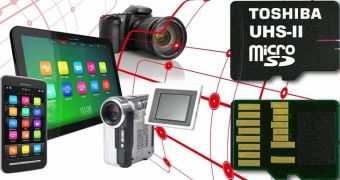It's one thing to release a random new memory card, and another to set a new standard for that particular market segment, as it is for any segment really. Nonetheless, Toshiba has managed to pull it off.
As the title has already revealed, the company has introduced what it claims are the fastest microSD memory cards ever made.
The performance varies according to capacity, as is usually the case of storage devices based on NAND Flash solid-state technology.
Nonetheless, even on the lower-capacity models, read and write speeds are more than decent. Enough to record top-quality video in 4K resolution and still have bandwidth to spare.
Here are the numbers: the 32 GB microSD memory card can attain 130 MB/s when writing data and 145 MB/s when reading.
The 64 GB card, however, can go all the way to 240 MB/s when writing and 260 MB/s when reading.
To put things into perspective, the minimum speed for recording 4K video, as dictated by the Ultra High Speed Class 3 specification (U3 for short), is of 30 MB/s.
Furthermore, the improvement in read and write speed over UHS-I microSD cards (also from Toshiba) is of 2.7 times and 8 times, respectively. 8 times better write speed. It may as well be some kind of record all on its own.
It's enough to bemoan the likelihood of most of that potential performance being wasted. After all, there aren't many cameras that can use the performance fully. Like, say, recording two streams at once or something.
It will be nice when copying the data from the card to a PC at least, and we suppose that tablets could use most of that throughput now that they can multitask just fine. Also, it will make moving large films or music libraries to your smartphone much quicker.
Anyway, the new microSD series from Toshiba America Electronic Components, Inc., (TAEC), comply with the UHS-II interface standard (the first in the industry to do it).
It's the high-speed serial bus interface defined in the SD Memory Card Standard Ver. 4.20. This is both a cause and a result of the performance, you could say.
4K2K video recording, live broadcast and content sharing/recording on the best cameras and camcorders is what Toshiba has in mind for its latest creations.
Other UHS-II microSD memory cards should be launched in the future, all with the same cryptographic security and high-level copyright protection functions as these ones.

 14 DAY TRIAL //
14 DAY TRIAL //